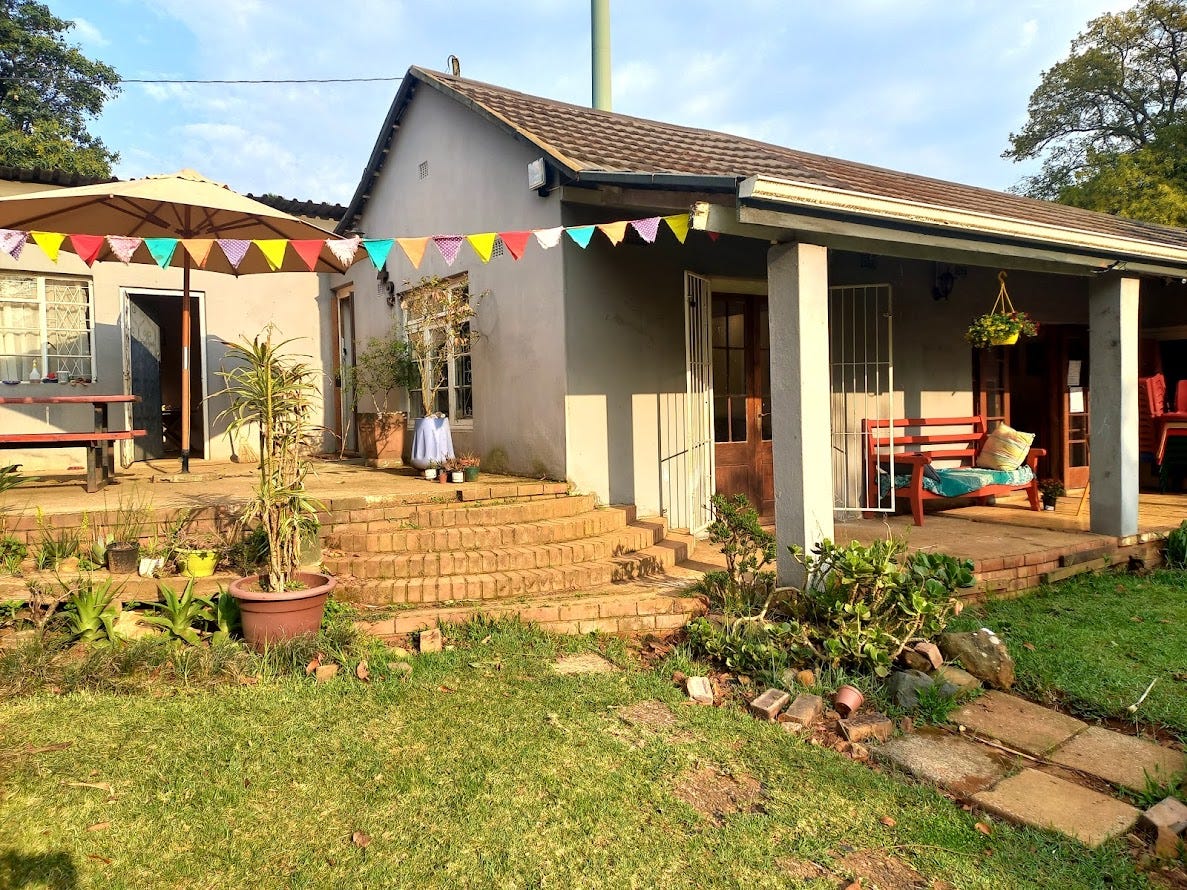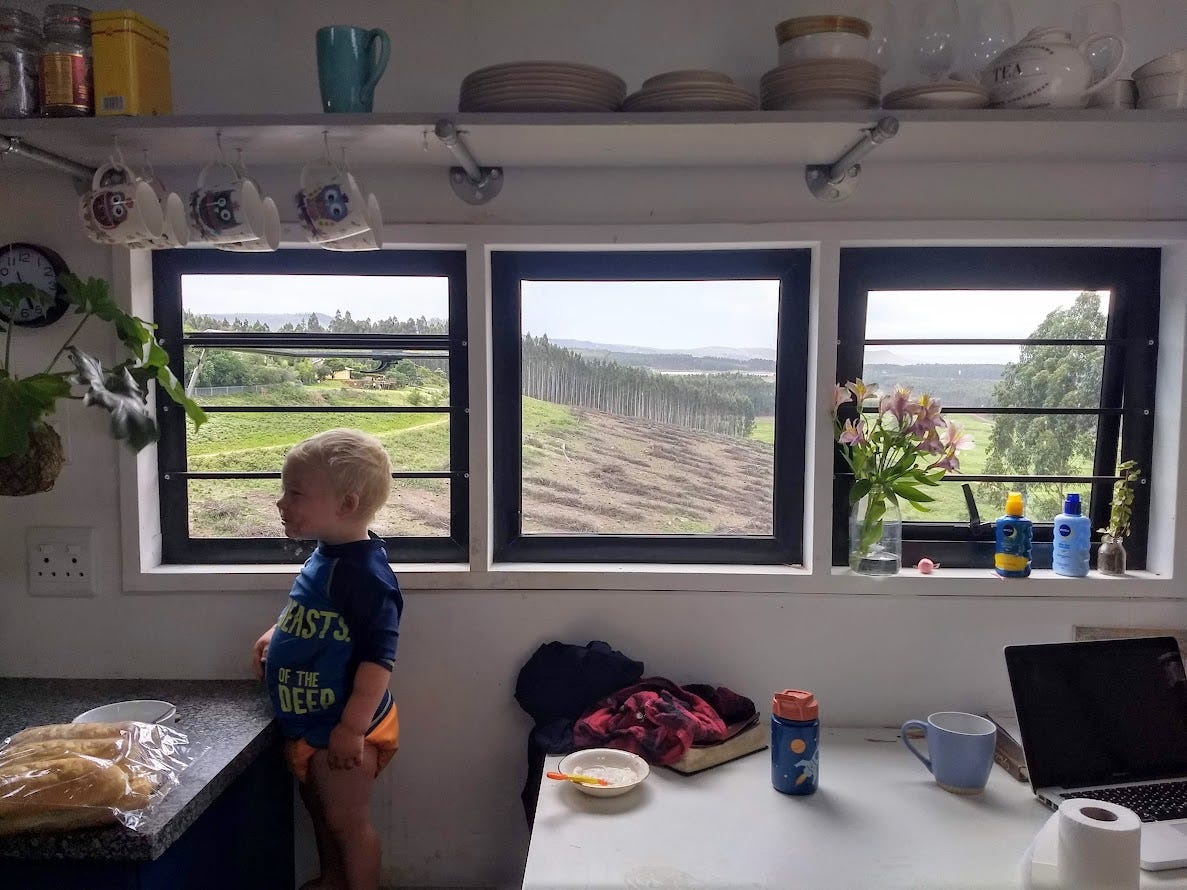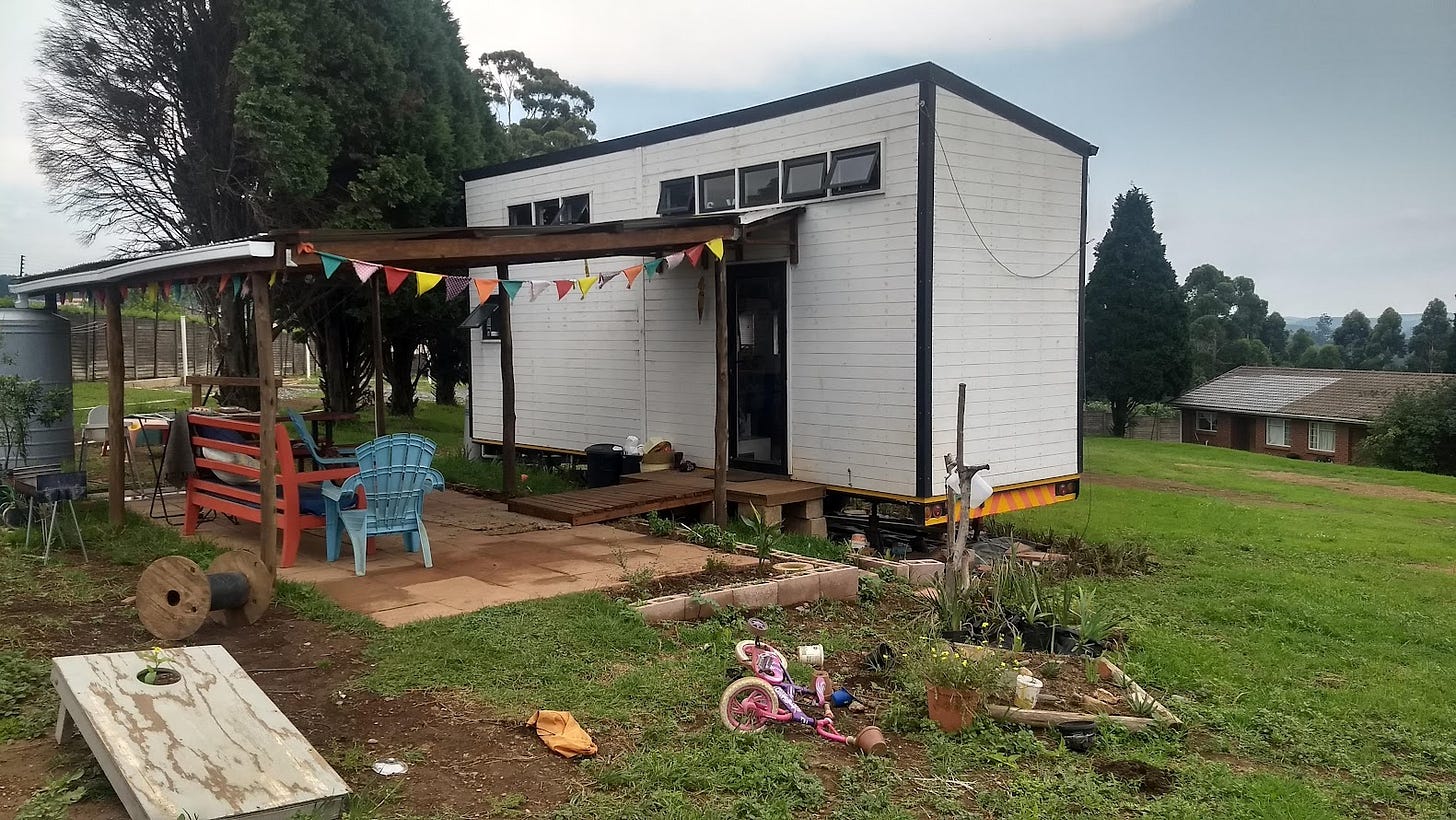Case Study: Windhover
From tiny house living to a 12-person homestead in South Africa
Editor’s note: this is a reader-submitted case study from Steph Ebert, who writes children's books and a substack newsletter about spaces where beauty and justice meet. She lives in South Africa with her family.
This is part of an ongoing series of deep dives on coliving spaces. To see others, visit the Supernuclear directory. If you want to contribute a case study of your community, awesome! Please find guidelines for submission in this post.
Name: Windhover (previously: The Tiny house)
Date founded: 2022 (previously: Tiny house 2018-2021)
Location: The Midlands of Kwa-Zulu Natal, South Africa
Rented or owned: owned
Amount of space: Main House has 5 bedrooms, 2 bathrooms (sub-divided to become the Main House: 3 bedrooms + 1 bath and the Side Flat: 2 bedrooms + 1 bath); Cottage 1 and Cottage 2 (both 2 bedroom, 1 bath); Tiny House (2 lofts, 1 bathroom); plus 3 acres of land including a field and lots of fruit and avocado trees.
Governance: The Eberts make all the decisions as the owners, but there are meetings about joint projects and events.
Origins
Our communal living started when we built our Tiny House on wheels. Well, that’s probably not completely true. It probably started when we hiked El Camino De Santiago in Spain, and had the experience of backpacking and being hosted by albergues along the journey. We loved the simplicity of the pilgrimage, as well as the friendships and community living we experienced there. That was probably what planted the seed for living in a tiny house.
After we finished our tiny build (an 8m wooden tiny house with 2 sleeping lofts), we parked for about a year and half in the giant backyard of a friend in a suburban area. Halfway through Covid we moved the Tiny House to the campus of a local Bible college where Steph’s parents live/work in a more diverse part of town. We were parked near the apartments for young families studying on the college campus and sort of “joined” that community.
We were coming up on four years in the tiny house, and our original plan had been to live in it for five years. With two kids (age 3 and 5) we were getting to the point where we’d need to figure out a new living situation soon. The 3 acre property next door to the Bible college suddenly became available and we bought it. We liked that we could keep the tiny house, that it was in the same diverse location, and that it was still close to family. There is a problem with affordable housing in the area, and we liked the idea of being able to “host” more people with our space by affordably renting out rooms and cottages, while still living in community.
We are interested in the Christian idea of hospitality, and making room for people beyond our nuclear family - as well as trying to think about what it looks like to live justly in a context of extreme economic inequality. Tiny living felt like one way to answer that question. We minimized expenses and “life complications” and had both more solidarity with our friends in lower economic brackets, and more time for a broader community. We felt that Windhover could be another way to think about this – taking on the risk and expense of landowning on behalf of neighbors who couldn’t afford that and sharing the space.

Inner workings
Currently, this feels very much like a solo operation when it comes to “running things”. We were able to get a mortgage with David’s full-time job and some family assistance. The “Side Flat”, Tiny House, and Cottages are rented out, and we’re essentially just landlords to everyone. Everyone has a written and signed agreement, and pays their own utilities and rent. However, there are different agreements with different people, depending on income level. We are trying to figure out how to balance out different forms of knowledge and power in the community. We have the most financial resources, and also the most financial investment/potential loss if things go badly. But we also are new to land/big home owning. One of the cottage tenants has been here for 10 years and has lots of institutional knowledge about the property with which he is very generous. One tenant exchanges yard work and maintenance for rent. Most people informally help out with yard/maintenance on a Saturday. It would be impossible to live here without others helping with these practical aspects of maintenance and yard work, since the space is just too big. Working together, whether it is fixing fences or harvesting avocados also helps cement the community together. We have different languages, education levels, and income levels represented, but physical labor is a pretty good equalizer, and when we all take breaks and eat together on work days, we form common ground.
We are also leasing out different parts of the property for small-scale farmers (at very subsidized rates). One tenant is growing lettuce for sale, and has also tried everything from rabbits, to geese, to ducks, to free range chickens, to chickens in movable pens. Every time a new animal is going to arrive, we have to talk through expectations (what do you do if the free range chickens are now pooping on our kitchen floor? What if they get through to the neighbors?)
Lessons learned
Reading Supernuclear has highlighted to me that although I (Steph) have basically lived in some form of community my whole life from college campuses with my parents as a child, to being in college myself, to garden cottages with my husband David, and then tiny house living in community with friends and neighbors, I don’t have much experience in power-sharing/group governance types of community living environments. While that type of governance seems like a lot of hassle in some cases (putting lots of stuff in writing, having more formal policies, managing conflict etc) it also has the benefit of a group shouldering the mental and financial burden, rather than it all being on an individual. What we are doing currently at Windhover is something bigger than just sharing our spare room with someone who needs a break, but also not a group-living commune either. I think there are disadvantages to being the sole financial investors in a community like this.
Going from tiny community living to landlords
The Tiny House was a wonderful balance of independence and privacy with community, in that our family could function as individuals, but we were forced to depend on others for things like a place to play on a rainy day. It got tiring at times being the ones “asking” all the time for things (borrowing a dryer for our clothes when it’s been pouring with rain for days, visiting a friend on a rainy day with our two toddlers, hosting a big birthday party at someone else’s house) - but on the other hand, we used our immediate community and neighborhood’s communal resources a lot more while living tiny. For example, we founded our neighborhood’s first public access playground/park at this time, in large part because we wanted a place to play and meet people! We had the time and energy to do this since we weren’t focused on fixing up our own property.
While parked on our friend’s property, we had the benefit of community support when raising young kids (this was great in the pandemic!). We couldn’t quite see their house from our tiny house, so had plenty of privacy, but were constantly in and out of each other’s houses, or sitting outside watching the kids play together. This was a life-saver during the four-o’clock “kids are crying for no reason, I need an adult, get me a cup of tea!” time every day. During this time both families grew from one to two kids, so we both navigated the newborn with a toddler stage with extra grown-ups nearby. We also ate together sometimes, and did a weekly meal-swap where one of us would cook double portions then send half to the other house. The pandemic lockdown was also great - we were so grateful it was a ratio of four adults to 4 children (under age 4!). South Africa had extremely strict lockdowns, and we were grateful to be able to swap childcare and working. However, once restrictions loosened, it was difficult with conflicting protocols to make decisions. We were also looking for a way to be more accessible to our friends who didn’t have cars and relied on public transport to visit us, which was difficult in this location. We wanted to be closer to grandparents. So we moved the Tiny House to the college campus where Steph’s parents lived.
When we moved to campus we had an “open porch” policy, where friends could come by and use our wifi on our porch whenever they wanted to. The outdoor space was basically our living room, but because there was always the tiny house to “retreat” to, we were able to have an okay balance between hosting others and individual family privacy. This was also nice during Covid, since the only place we could host was outside anyway.
We took the leap to buy Windhover and become landlords mostly because we liked this geographic location. It’s within walking distance for our friends who don’t have cars (or just one stop on the mini-bus public transport route). There is a pedestrian gate between our property and the college campus, so our kids can walk to their grandparents relatively unsupervised. We have another family member renting a cottage at Windhover, so we have more interaction with that family member now, too: weekly meals and game nights. But the jump from living in community in a tiny house (basically, living as a land-renter) to being a land-lord has been massive. And we didn’t go from tiny living to one house, we went from tiny living to essentially being responsible for five separate dwellings and a lot of land. These days, we are not investing in our community park anymore! Free time has all gone towards getting this overgrown property under control, to benefit the 12 people who live here and anyone else who comes to visit and use the more communal resources.
On the other hand, it’s great to be able to have friends from our old neighborhood and our current community come together and fit in our house for Thanksgiving, even when it’s raining! This just wasn’t possible with tiny house living. We were also able to have David’s dad from the USA come stay for a month with us (also not possible in the tiny house). Instead of borrowing other people’s dryers, we are now the ones sharing our washing machine (with those who live at Windhover, but also just friends coming to use Wifi). So in some ways, we feel we have switched from being guests to being hosts in this season.
Thanks Stephanie for sharing your story! An additional resource for anyone interested in building a tiny home, David documented his tiny house build here which also has more details about expenses, and building a wooden tiny house in South Africa.
Suggested further reading:
If you found this helpful, know someone else who might? You know what to do!











Thank you for hosting! I would love to visit if I'm ever in South Africa